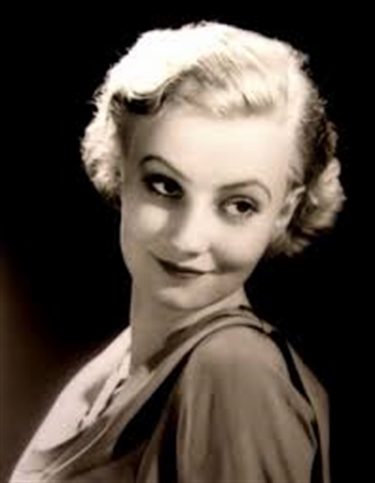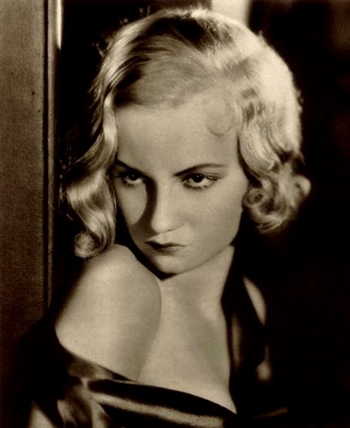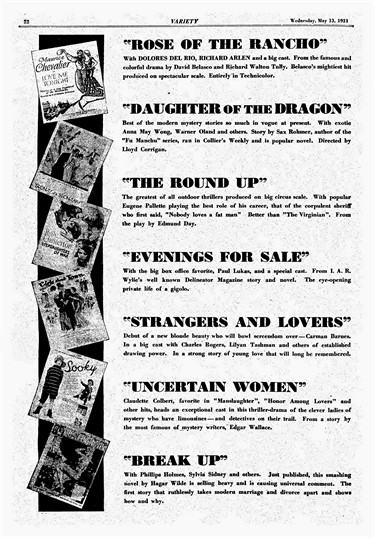Five-Minute Movie Star: Carman Barnes in Hollywood, Part 2
Like her Schoolgirl heroine Naomi Bradshaw, Carman Barnes shared a suite at boarding school with two sisters, Clara and Mary Jackson. And in Carman’s case, she remained close to the Jackson girls for the rest of her life. In April 1931, Carman wrote a letter to Clara Jackson that survives in her papers at the University of Rochester. I quote it here in its entirety, with Carman’s occasional misspellings left intact:
 Dearest Clara,
Dearest Clara,
No, Miss Barnes is not temperamental, glamorous or mysterious as yet. And she actually doesn’t bite. And Carman would love to have the two little Jackson girls come to visit her in the sad little town of Hollywood, if she doesn’t take that little actress away on location. You see, Miss Barnes’ first picture may be made in Florida, but even if it isn’t, Carman would be a dull hostess having to put the blonde star to bed every night at eight o’clock, tucking her in between the ermine lined sheets and smelling her breath to be sure she hasn’t sneaked a high ball. Miss Barnes will tell you that it’s no cinch being a movie star. However we’ll see how things work out, and how much breathing space she’ll get between pictures. Old writer Carman is sailing for Europe in July–believe it or not–which you probably don’t by now.
The screen’s newest siren—who kisses—and wonders if her chin’s at the right angle (before the camera)–doesn’t attend many Hollywood parties, so it might be dull for the little Jacksons. Hollywood parties are—Hollywood parties. Very ginny, and very disillusioning. The last one Miss Barnes went to, an important studio executive engaged in a little battle on the floor with an important Broadway playwright–with much rolling gnashing of teeth, blackening of eyes, and —it is said shamefully—biting! All the sweet young thing’s were there too, Mary Brian, Janet Gaynor, Frances Dee, Philips Holmes, Betty Davis— and you know, they are very, very nice. So is Carman Barnes. She went home very ill, and it took the young thing two days to recover. But honestly, I can’t stand that sort of thing, and it happens so often and so easily here. It would be bad if it ever reached the newspapers, too. Hollywood is nutty over gossip–at any cost.
When the young actress isn’t working, I loll on the beach, ride horseback three or four times a week. A young English boy and I ride early Sunday mornings, way up in the hills. We gallop up, swing around overhanging cliffs, almost leap off into the air, swerve, brandish our sticks, and shriek: “We have met the enemy in the passes and he is ours!” Try it some time. It’s great sport. I have a nice tan, too, and am very healthy.
After you’ve once “been places” in Hollywood, there’s no reason to go again. Everything is of a sameness, the people are the same, movie people, they talk about the same things, movies, they eat the same thing, movies, and they drink the same thing, movies. Everyone likes to go to the Brown Derby once–but after a few times, it’s nothing but a small town café with hard seats and bad food. Primieres are fun—once, and sort of amazing, too, with thousands of people lining the side walks, great fires burning in the streets, carpets, canopies, flowers, radio announcers, ermine coats, stars swamped with orchids, glaring arc lights, and the “herd” yelling for autographs. But after one–they’re all alike, maybe the lights are bigger, the fires brighter–for one star than for another, but that’s all. Now, have I disillusioned you in your glorified conception of Hollywood. You might like it, I don’t know. There are so few people here worth knowing, so few who have any back ground, any culture, any intelligence, any humor.
I go out with very few people. Tom Douglas, for one, the boy who is to play with me in my picture. He is charming, very humorous. He is southern and from a good family. That can’t be said of many people out here. And more than anything, he is not a ham, nor a “pretty” movie actor. I go out with a young producer and a young scenario writer, and Jack Spurlock, a boy from home who came out with us. That’s practically all. You’d be surprised how quiet the lives are that most people lead in Hollywood. Did you know that the streets were deserted by twelve o’clock?
I’ll send you a picture, if I ever get time to mail it off. And write to me, you scamp— I still love you loads, darling-
Carman
As I said before, the kid could write.
 By February 1931 Paramount was spreading the word of their new discovery. The studio sent a letter to all their theater managers — and Paramount had the largest theater chain in the country — introducing Carman and telling them (according to Variety) “how glad she is to be a picture star as well as a writer.” For good measure, managers were offered an autographed picture of Miss Barnes. It would be interesting to know if any managers took Paramount up on the offer, and if any of the photos survive. (At about this same time, reports began to circulate that Paramount had also paid Carman $30,000 for the screen rights to Schoolgirl. Whether because of the novel’s subject matter or the play’s lukewarm reception on Broadway, nothing ever came of that, and the idea was soon dropped even by the gossips.)
By February 1931 Paramount was spreading the word of their new discovery. The studio sent a letter to all their theater managers — and Paramount had the largest theater chain in the country — introducing Carman and telling them (according to Variety) “how glad she is to be a picture star as well as a writer.” For good measure, managers were offered an autographed picture of Miss Barnes. It would be interesting to know if any managers took Paramount up on the offer, and if any of the photos survive. (At about this same time, reports began to circulate that Paramount had also paid Carman $30,000 for the screen rights to Schoolgirl. Whether because of the novel’s subject matter or the play’s lukewarm reception on Broadway, nothing ever came of that, and the idea was soon dropped even by the gossips.)
The seeds planted with the fan mags in January began bearing fruit in April. In Photoplay, gossip columnist Cal York’s “Monthly Broadcast of Hollywood Goings-On!” trumpeted, “Girl novelist turns actress!”:
Hollywood’s newest Cinderella is Carman Dee Barnes, eighteen-year old writer who ground out a story called “Schoolgirl” when she was fifteen.
Last fall she went west for Paramount to write. Now she’s to play the leading role in a story written by herself.
She’s reported to have said that she’s a little shy of pictures because she has to write down to her audiences!
This, from a kid writer of frenzied flapper fiction.
Are we allowed a small chuckle, or a modest guffaw? Sure!
That same month — April 18, to be precise — an ad in Motion Picture Herald listed Carman among Paramount’s “Screen Luminaries”, already placing her in such company as Harold Lloyd, Marlene Dietrich, the Marx Brothers, Maurice Chevalier — and yes, Clara Bow. Her first picture — the one that in January interviewers had heard about as Debutante or A Debutante Confesses or Confessions of a Debutante — had undergone a change of title, which would be the source of some confusion when those interviews finally saw print in May and June. Now, according to Paramount, the picture was Strangers and Lovers, “featuring Carman Barnes and Tom Douglas. Directed by Richard Wallace. A tale of a girl who is afraid she is wicked.”
 In May, along with profiles and prominent plugs in Screenland and Silver Screen, Carman scored an item in Picture Play’s “Hollywood Highlights” column by Edwin and Elza Schallert that paid tribute to her skill at the age-old southern belle tease:
In May, along with profiles and prominent plugs in Screenland and Silver Screen, Carman scored an item in Picture Play’s “Hollywood Highlights” column by Edwin and Elza Schallert that paid tribute to her skill at the age-old southern belle tease:
What chance will a girl in her teens now have to impress a movie producer, unless 1. She has tossed off a couple of novels? 2. She has gifts as a sculptor, playwright and musician? 3. Possesses a flair for snappy and sophisticated conversation? 4. Is — in a word — just a whirlwind of intellectuality?
Carman Barnes, eighteen-year-old Paramount discovery, sets a standard that must be wretchedly depressing to any young seeker of celluloid honors. For she has a veritable galaxy of smart attributes, including those above enumerated.
And what a free, informal soul this young maid of movieland is, incidentally! Our first glimpse of Carman was on a breezy day in the broad open spaces of the studio, clad in a futuristic-looking bath robe, and gayly diverting an audience of three wise old scenario writers with her piquant repartee. Carman was waiting photographic test time, and if the breezes blew lightly on her loose-fitting outer garment, she should worry. Persiflage and the laughter took complete precendence over the day’s chilliness or the wind’s revealing whimsies with a lady’s boudoir habiliments.
An insouciante, charming, and distinctly clever young woman from the Southland is this precocious author of “School Girl” and “Beau Lover,” who is to appear in her own story, “Débutante.” Amazing as it may seem, she sometimes photographs not unlike Garbo.
(As a side note, Mr. and Mrs. Schallert in those days had an eight-year-old son, Billy, who would grow up to be one of the most prolific actors in Hollywood history, playing — among hundreds of other roles — Dobie Gillis’s English teacher, Patty Duke’s father, and Milton the Toaster for Kellogg’s Pop-Tarts. William Schallert left us last year at the age of 93.)
 The change from (Confessions of a) Debutante (Confesses) to Strangers and Lovers became official in an ad Paramount placed in the May 13 issue of Variety: “Debut of a new blonde beauty who will bowl screendom over — Carman Barnes. In a big cast with Charles Rogers, Lilyan Tashman and others of established drawing power. In a strong story of young love that will long be remembered.” So this was the fulfillment of Variety’s February 11 item — two veterans, Charles “Buddy” Rogers and Lilyan Tashman (not to mention “others of established drawing power”), were coming aboard to do some of the heavy lifting for Carman and her “co-star” Tom Douglas. And in case you’ve lost track, in less than a month the story has gone from “a tale of a girl who is afraid she is wicked” to an “absorbing drama of an innocent-wise 19-year [old] charmer in a barracks town” to “a strong story of young love that will be long remembered.” An observant reader might have thought that somebody at Paramount was having trouble remembering that story for very long — might indeed have wondered if there was a story at all.
The change from (Confessions of a) Debutante (Confesses) to Strangers and Lovers became official in an ad Paramount placed in the May 13 issue of Variety: “Debut of a new blonde beauty who will bowl screendom over — Carman Barnes. In a big cast with Charles Rogers, Lilyan Tashman and others of established drawing power. In a strong story of young love that will long be remembered.” So this was the fulfillment of Variety’s February 11 item — two veterans, Charles “Buddy” Rogers and Lilyan Tashman (not to mention “others of established drawing power”), were coming aboard to do some of the heavy lifting for Carman and her “co-star” Tom Douglas. And in case you’ve lost track, in less than a month the story has gone from “a tale of a girl who is afraid she is wicked” to an “absorbing drama of an innocent-wise 19-year [old] charmer in a barracks town” to “a strong story of young love that will be long remembered.” An observant reader might have thought that somebody at Paramount was having trouble remembering that story for very long — might indeed have wondered if there was a story at all.
In May and June the gossip columns were liberally salted with items keeping Carman’s name front and center. Gladys Hall in Motion Picture and Cal York in Photoplay mentioned how Schoolgirl had gotten her “expelled from” (York) or “asked to leave” (Hall) her tony New York prep school. Meanwhile, Edward Churchill in Silver Screen asserted that she did manage to graduate from Ward Belmont in Nashville (the school she was attending when she wrote that first novel) “just after her seventeenth birthday.”
An item in the June Motion Picture mentioned Carman gushing over “a star famous for her vamp roles” (Who?, I wonder; Mae Murray? Nita Naldi? Louise Brooks? Theda Bara?), and clasping her hands in admiration of the lady’s orchid corsage: “Ah! how I adore orchids! I wish I could wear them — but I’m too young!”
Perhaps most amusing of all, Picture Play’s New York correspondent, Karen Hollis, went trolling among the bellhops at Carman’s former hotel:
Is She an Actress? The announcement that Carman Barnes, the child prodigy author, was also to act for Paramount fell like a bombshell in the New York hotel where she used to live. It happens that I live there now, and all the bell boys think I ought to know her just because I, too, have a typewriter.
They say she is an awfully smart kid, “Smart enough to act dumb and wistful and helpless when there is something she wants.” “Act? I should say she can. She was acting all the time, especially around the lobby and library when a flock of college boys blew in for the week-end.”
“Beautiful? Well, she’s no Claudette Colbert, but she’s pert and cute. She’ll be all right if people don’t make too much fuss over her. She loves attention. Her mother should have spanked her and torn up that dirty book she wrote.”
Reading that item, Carman the mature-beyond-her-years phenomenon suddenly sounds 18 again. Or rather, 17 — the age at which those New York bellhops knew her (and no doubt eagerly devoured “that dirty book she wrote”).
In that same June issue of Picture Play, Edwin and Elza Schallert in “Hollywood Highlights” commiserated with Carman for having “to sign her movie contract in the presence of a judge, because she happens to be a minor!…Movie companies arrange to have contracts with minors signed this way so that they may not be broken on the grounds of youthful incompetency of the player in business matters.” But this was old news by June: that hearing had happened way back in March. Still, it was publicity, and it lent the juggernaut of Carman’s approaching stardom the imprimatur of the California State Superior Court.
Anyhow, the days of magazine profiles, ballyhooing ads and gossip-column plugs, of Carman’s partying and horseback riding and enduring the hard seats and bad food of the Brown Derby, were reaching a climax — Carman was finally going before the cameras.
